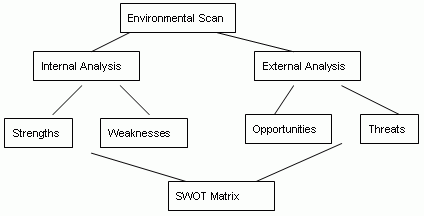Introduction
SWOT analysis refers to the analysis of the strategic environment that impact on the activities of an organization. Under SWOT analysis, the internal factors that originate from the firm are categorized into strengths denoted by S or weaknesses denoted by W, while those factors that are external to the organization are categorized into opportunities denoted by O and threats denoted by T. The analysis of the internal and external factors that impact on an organization is a critical aspect for the strategic planning process of an organization. SWOT analysis is important for availing information that is helpful in harmonizing the firm’s capital and capabities to the requirements of the competitive atmosphere that the firm operates in. Thus, SWOT analysis is critical in the formulation and selection strategies of a company (Wheelen & Hunger, 1998).
Advantages of SWOT analysis
SWOT analysis is a critical tool for decision making and understanding all the business situations facing an organization. The titles under the SWOT analysis present an exceptional structure for undertaking an appraisal of an organization’s strategy, position and direction. The figure below represents the SWOT analysis implementation procedure.

Focusing on the external environment, there are the threats and opportunities that can act as a disadvantage and an advantage to a firm. All businesses are impacted on by the external environment such as the legal, political, technological, and cultural factors. Thus, conducting SWOT analysis enables a business to discover the innovation opportunities that may be available in the external environment (Cleland, 1997). An organization may be faced with a threat of becoming obsolete; conducting SWOT analysis may avail an innovative way of discovering the threat and converting it into an opportunity.
Conducting SWOT analysis may enable an organization to find answers to some questions that are critical to the growth of the organization. SWOT analysis may enable a company to identify whether it has the expertise required to provide valuable and useful ideas for the development of new products and whether there are enough resources to produce new products; and the necessary changes that need to be implemented in the organizational in order to make it more efficient (Dealtry, 1992). The analysis may also be critical in providing innovative opportunities for undertaking government legislation softening, development of new and more advanced technology and growing the business trend and increasing the customer base for an organization.
Criticisms of SWOT analysis
Despite the numerous planning advantages that SWOT analysis entail, many organizations have found the strategy to be harmful to innovation efforts. The majority of recorded usages of SWOT analysis report that the strategy results in a poorly structured, broad, and a rapidly conducted exercise that produces inconsistent factors. These are the factors that are regarded by the proponents of SWOT analysis as the components of strategic solutions. However, in a substantial amount of cases, the strategies have proved inefficient in promoting innovation.
Furthermore, SWOT analysis does not permit appropriate communication, examination, and authentication of all the internal and external issues that affect an organization. Thus, in these cases relying on SWOT analysis may prove to be less efficient in the generation of innovative strategies that are viable in the long run. Furthermore, SWOT analysis is not meant for the input strategy generation process (Dealtry, 1992). If this fact is known to the personnel that are engaged in conducting the SWOT analysis, they may tend to compromise on the quality of inputs and this may result in less desirable outputs. Furthermore, this may lead to wrong decisions and compromised innovative strategies.
References
- Cleland, D. F. (1997). Strategic Management. (6th ed.). Upper Saddle River, NJ: Prentice Hall.
- Dealtry, T. R. (1992). Dynamic SWOT Analysis. Birmingham, UK: Dynamic SWOT Associates.
- Wheelen, T. L. & Hunger, J. D. (1998). Strategic Management and Business Policy. (5th ed.). Reading, MA: Addison-Wesley.